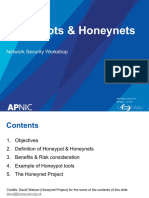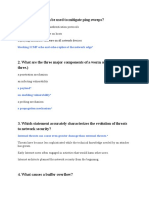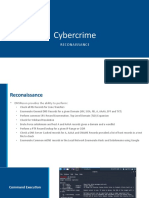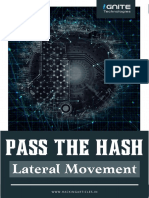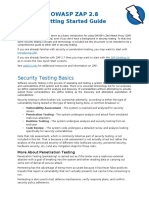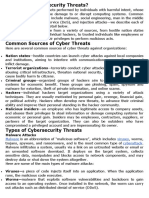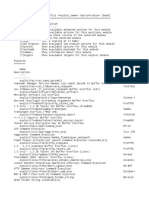0 ratings0% found this document useful (0 votes)
190 viewsWeb Application Pentesting Checklist
Uploaded by
Getaneh AlehegnCopyright
© © All Rights Reserved
Available Formats
Download as PDF, TXT or read online on Scribd
0 ratings0% found this document useful (0 votes)
190 viewsWeb Application Pentesting Checklist
Uploaded by
Getaneh AlehegnCopyright
© © All Rights Reserved
Available Formats
Download as PDF, TXT or read online on Scribd
You are on page 1/ 23
Web Application PentestingChecklist
Web Application Pentesting
Checklist
Document Classification: Internal
Prepared by: Cyber & IT Security Dep’t
Web Application PentestingChecklist
Information Gathering
1. Open Source Reconnaissance
☐ Perform Google Dorks search
☐ Perform OSINT
2. Fingerprinting Web Server
☐ Find the type of Web Server
☐ Find the version details of the Web Server
3. Looking For Metafiles
☐ View the Robots.txt file
☐ View the Sitemap.xml file
☐ View the Humans.txt file
☐ View the Security.txt file
4. Enumerating Web Server’s Applications
☐ Enumerating with Nmap
☐ Enumerating with Netcat
☐ Perform a DNS lookup
☐ Perform a Reverse DNS lookup
Prepared by: Cyber & IT Security Dep’t
Web Application PentestingChecklist
5. Review The Web Contents
☐ Inspect the page source for sensitive info
☐ Try to find Sensitive Javascript codes
☐ Try to find any keys
☐ Make sure the autocomplete is disabled
6. Identifying Application’s Entry Points
☐ Identify what the methods used are?
☐ Identify where the methods used are?
☐ Identify the Injection point
7. Mapping Execution Paths
☐ Use Burp Suite
☐ Use Dirsearch
☐ Use Gobuster
8. Fingerprint Web Application Framework
☐ Use the Wappalyzer browser extension
☐ Use Whatweb
☐ View URL extensions
☐ View HTML source code
☐ View the cookie parameter
☐ View the HTTP headers
9. Map Application Architecture
☐ Map the overall site structure
Prepared by: Cyber & IT Security Dep’t
Web Application PentestingChecklist
Configuration & Deployment Management Testing
1. Test Network Configuration
☐ Check the network configuration
☐ Check for default settings
☐ Check for default credentials
2. Test Application Configuration
☐ Ensure only required modules are used
☐ Ensure unwanted modules are disabled
☐ Ensure the server can handle DOS
☐ Check how the application is handling 4xx & 5xx errors
☐ Check for the privilege required to run
☐ Check logs for sensitive info
3. Test File Extension Handling
☐ Ensure the server won’t return sensitive extensions
☐ Ensure the server won’t accept malicious extensions
☐ Test for file upload vulnerabilities
4. Review Backup & Unreferenced Files
☐ Ensure unreferenced files don’t contain any sensitive info
☐ Ensure the namings of old and new backup files
☐ Check the functionality of unreferenced pages
5. Enumerate Infrastructure & Admin Interfaces
☐ Try to find the Infrastructure Interface
☐ Try to find the Admin Interface
☐ Identify the hidden admin functionalities
Prepared by: Cyber & IT Security Dep’t
Web Application PentestingChecklist
6. Testing HTTP Methods
☐ Discover the supported methods
☐ Ensure the PUT method is disabled
☐ Ensure the OPTIONS method is disabled
☐ Test access control bypass
☐ Test for XST attacks
☐ Test for HTTP method overriding
7. Test HSTS
☐ Ensure HSTS is enabled
8. Test RIA Cross Domain Policy
☐ Check for Adobe’s Cross Domain Policy
☐ Ensure it has the least privilege
9. Test File Permission
☐ Ensure the permissions for sensitive files
☐ Test for directory enumeration
10. Test For Subdomain Takeover
☐ Test DNS, A, and CNAME records for subdomain takeover
☐ Test NS records for subdomain takeover
☐ Test 404 response for subdomain takeover
11. Test Cloud Storage
☐ Check the sensitive paths of AWS
☐ Check the sensitive paths of Google Cloud
☐ Check the sensitive paths of Azure
Prepared by: Cyber & IT Security Dep’t
Web Application PentestingChecklist
Identity Management Testing
1. Test Role Definitions
☐ Test for forced browsing
☐ Test for IDOR (Insecure Direct Object Reference)
☐ Test for parameter tampering
☐ Ensure low privilege users can’t able to access high privilege resources
2. Test User Registration Process
☐ Ensure the same user or identity can’t register again and again
☐ Ensure the registrations are verified
☐ Ensure disposable email addresses are rejected
☐ Check what proof is required for successful registration
3. Test Account Provisioning Process
☐ Check the verification for the provisioning process
☐ Check the verification for the de-provisioning process
☐ Check the provisioning rights for an admin user to other users
☐ Check whether a user is able to de-provision themself or not?
☐ Check for the resources of a de-provisioned user
4. Testing For Account Enumeration
☐ Check the response when a valid username and password entered
☐ Check the response when a valid username and an invalid password entered
☐ Check the response when an invalid username and password entered
☐ Ensure the rate-limiting functionality is enabled in username and password
fields
Prepared by: Cyber & IT Security Dep’t
Web Application PentestingChecklist
5. Test For Weak Username Policy
☐ Check the response for both valid and invalid usernames
☐ Check for username enumeration
Authentication Testing
1. Test For Un-Encrypted Channel
☐ Check for the HTTP login page
☐ Check for the HTTP register or sign-in page
☐ Check for HTTP forgot password page
☐ Check for HTTP change password
☐ Check for resources on HTTP after logout
☐ Test for forced browsing to HTTP pages
2. Test For Default Credentials
☐ Test with default credentials
☐ Test organization name as credentials
☐ Test for response manipulation
☐ Test for the default username and a blank password
☐ Review the page source for credentials
3. Test For Weak Lockout Mechanism
☐ Ensure the account has been locked after 3-5 incorrect attempts
☐ Ensure the system accepts only the valid CAPTCHA
☐ Ensure the system rejects the invalid CAPTCHA
☐ Ensure CAPTCHA code regenerated after reloaded
☐ Ensure CAPTCHA reloads after entering the wrong code
☐ Ensure the user has a recovery option for a lockout account
Prepared by: Cyber & IT Security Dep’t
Web Application PentestingChecklist
4. Test For Bypassing Authentication Schema
☐ Test forced browsing directly to the internal dashboard without login
☐ Test for session ID prediction
☐ Test for authentication parameter tampering
☐ Test for SQL injection on the login page
☐ Test to gain access with the help of session ID
☐ Test multiple logins allowed or not?
5. Test For Vulnerable Remember Password
☐ Ensure that the stored password is encrypted
☐ Ensure that the stored password is on the server-side
6. Test For Browser Cache Weakness
☐ Ensure proper cache-control is set on sensitive pages
☐ Ensure no sensitive data is stored in the browser cache storage
7. Test For Weak Password Policy
☐ Ensure the password policy is set to strong
☐ Check for password reusability
☐ Check the user is prevented to use his username as a password
☐ Check for the usage of common weak passwords
☐ Check the minimum password length to be set
☐ Check the maximum password length to be set
8. Testing For Weak Security Questions
☐ Check for the complexity of the questions
☐ Check for brute-forcing
Prepared by: Cyber & IT Security Dep’t
Web Application PentestingChecklist
9. Test For Weak Password Reset Function
☐ Check what information is required to reset the password
☐ Check for password reset function with HTTP
☐ Test the randomness of the password reset tokens
☐ Test the uniqueness of the password reset tokens
☐ Test for rate limiting on password reset tokens
☐ Ensure the token must expire after being used
☐ Ensure the token must expire after not being used for a long time
10. Test For Weak Password Change Function
☐ Check if the old password asked to make a change
☐ Check for the uniqueness of the forgotten password
☐ Check for blank password change
☐ Check for password change function with HTTP
☐ Ensure the old password is not displayed after changed
☐ Ensure the other sessions got destroyed after the password change
11. Test For Weak Authentication In Alternative Channel
☐ Test authentication on the desktop browsers
☐ Test authentication on the mobile browsers
☐ Test authentication in a different country
☐ Test authentication in a different language
☐ Test authentication on desktop applications
☐ Test authentication on mobile applications
Prepared by: Cyber & IT Security Dep’t
Web Application PentestingChecklist
Authorization Testing
1. Testing Directory Traversal File Include
☐ Identify the injection point on the URL
☐ Test for Local File Inclusion
☐ Test for Remote File Inclusion
☐ Test Traversal on the URL parameter
☐ Test Traversal on the cookie parameter
2. Testing Traversal With Encoding
☐ Test Traversal with Base64 encoding
☐ Test Traversal with URL encoding
☐ Test Traversal with ASCII encoding
☐ Test Traversal with HTML encoding
☐ Test Traversal with Hex encoding
☐ Test Traversal with Binary encoding
☐ Test Traversal with Octal encoding
☐ Test Traversal with Gzip encoding
3. Testing Travesal With Different OS Schemes
☐ Test Traversal with Unix schemes
☐ Test Traversal with Windows schemes
☐ Test Traversal with Mac schemes
4. Test Other Encoding Techniques
☐ Test Traversal with Double encoding
☐ Test Traversal with all characters encode
☐ Test Traversal with only special characters encode
Prepared by: Cyber & IT Security Dep’t
Web Application PentestingChecklist
5. Test Authorization Schema Bypass
☐ Test for Horizontal authorization schema bypass
☐ Test for Vertical authorization schema bypass
☐ Test override the target with custom headers
6. Test For Privilege Escalation
☐ Identify the injection point
☐ Test for bypassing the security measures
☐ Test for forced browsing
☐ Test for IDOR
☐ Test for parameter tampering to high privileged user
7. Test For Insecure Direct Object Reference
☐ Test to change the ID parameter
☐ Test to add parameters at the endpoints
☐ Test for HTTP parameter pollution
☐ Test by adding an extension at the end
☐ Test with outdated API versions
☐ Test by wrapping the ID with an array
☐ Test by wrapping the ID with a JSON object
☐ Test for JSON parameter pollution
☐ Test by changing the case
☐ Test for path traversal
☐ Test by changing words
☐ Test by changing methods
Prepared by: Cyber & IT Security Dep’t
Web Application PentestingChecklist
Session Management Testing
1. Test For Session Management Schema
☐ Ensure all Set-Cookie directives are secure
☐ Ensure no cookie operation takes place over an unencrypted channel
☐ Ensure the cookie can’t be forced over an unencrypted channel
☐ Ensure the HTTPOnly flag is enabled
☐ Check if any cookies are persistent
☐ Check for session cookies and cookie expiration date/time
☐ Check for session fixation
☐ Check for concurrent login
☐ Check for session after logout
☐ Check for session after closing the browser
☐ Try decoding cookies (Base64, Hex, URL, etc)
2. Test For Cookie Attributes
☐ Ensure the cookie must be set with the secure attribute
☐ Ensure the cookie must be set with the path attribute
☐ Ensure the cookie must have the HTTPOnly flag
3. Test For Session Fixation
☐ Ensure new cookies have been issued upon a successful authentication
☐ Test manipulating the cookies
4. Test For Exposed Session Variables
☐ Test for encryption
☐ Test for GET and POST vulnerabilities
☐ Test if GET request incorporating the session ID used
☐ Test by interchanging POST with GET method
Prepared by: Cyber & IT Security Dep’t
Web Application PentestingChecklist
5. Test For Back Refresh Attack
☐ Test after password change
☐ Test after logout
6. Test For Cross Site Request Forgery
☐ Check if the token is validated on the server-side or not
☐ Check if the token is validated for full or partial length
☐ Check by comparing the CSRF tokens for multiple dummy accounts
☐ Check CSRF by interchanging POST with GET method
☐ Check CSRF by removing the CSRF token parameter
☐ Check CSRF by removing the CSRF token and using a blank parameter
☐ Check CSRF by using unused tokens
☐ Check CSRF by replacing the CSRF token with its own values
☐ Check CSRF by changing the content type to form-multipart
☐ Check CSRF by changing or deleting some characters of the CSRF token
☐ Check CSRF by changing the referrer to Referrer
☐ Check CSRF by changing the host values
☐ Check CSRF alongside clickjacking
7. Test For Logout Functionality
☐ Check the logout function on different pages
☐ Check for the visibility of the logout button
☐ Ensure after logout the session was ended
☐ Ensure after logout we can’t able to access the dashboard by pressing the
back button
☐ Ensure proper session timeout has been set
Prepared by: Cyber & IT Security Dep’t
Web Application PentestingChecklist
8. Test For Session Timeout
☐ Ensure there is a session timeout exists
☐ Ensure after the timeout, all of the tokens are destroyed
9. Test For Session Puzzling
☐ Identify all the session variables
☐ Try to break the logical flow of the session generation
10. Test For Session Hijacking
☐ Test session hijacking on target that doesn’t has HSTS enabled
☐ Test by login with the help of captured cookies
Input Validation Testing
1. Test For Reflected Cross Site Scripting
☐ Ensure these characters are filtered <>’’&””
☐ Test with a character escape sequence
☐ Test by replacing < and > with HTML entities < and >
☐ Test payload with both lower and upper case
☐ Test to break firewall regex by new line /r/n
☐ Test with double encoding
☐ Test with recursive filters
☐ Test injecting anchor tags without whitespace
☐ Test by replacing whitespace with bullets
☐ Test by changing HTTP methods
Prepared by: Cyber & IT Security Dep’t
Web Application PentestingChecklist
2. Test For Stored Cross Site Scripting
☐ Identify stored input parameters that will reflect on the client side
☐ Look for input parameters on the profile page
☐ Look for input parameters on the shopping cart page
☐ Look for input parameters on the file upload page
☐ Look for input parameters on the settings page
☐ Look for input parameters on the forum, comment page
☐ Test uploading a file with XSS payload as its file name
☐ Test with HTML tags
3. Test For HTTP Parameter Pollution
☐ Identify the backend server and parsing method used
☐ Try to access the injection point
☐ Try to bypass the input filters using HTTP Parameter Pollution
4. Test For SQL Injection
☐ Test SQL Injection on authentication forms
☐ Test SQL Injection on the search bar
☐ Test SQL Injection on editable characteristics
☐ Try to find SQL keywords or entry point detections
☐ Try to inject SQL queries
☐ Use tools like SQLmap or Hackbar
☐ Use Google dorks to find the SQL keywords
☐ Try GET based SQL Injection
☐ Try POST based SQL Injection
☐ Try COOKIE based SQL Injection
☐ Try HEADER based SQL Injection
Prepared by: Cyber & IT Security Dep’t
Web Application PentestingChecklist
☐ Try SQL Injection with null bytes before the SQL query
☐ Try SQL Injection with URL encoding
☐ Try SQL Injection with both lower and upper cases
☐ Try SQL Injection with SQL Tamper scripts
☐ Try SQL Injection with SQL Time delay payloads
☐ Try SQL Injection with SQL Conditional delays
☐ Try SQL Injection with Boolean based SQL
☐ Try SQL Injection with Time based SQL
5. Test For LDAP Injection
☐ Use LDAP search filters
☐ Try LDAP Injection for access control bypass
6. Testing For XML Injection
☐ Check if the application is using XML for processing
☐ Identify the XML Injection point by XML metacharacter
☐ Construct XSS payload on top of XML
7. Test For Server Side Includes
☐ Use Google dorks to find the SSI
☐ Construct RCE on top of SSI
☐ Construct other injections on top of SSI
☐ Test Injecting SSI on login pages, header fields, referrer, etc
8. Test For XPATH Injection
☐ Identify XPATH Injection point
☐ Test for XPATH Injection
Prepared by: Cyber & IT Security Dep’t
Web Application PentestingChecklist
9. Test For IMAP SMTP Injection
☐ Identify IMAP SMTP Injection point
☐ Understand the data flow
☐ Understand the deployment structure of the system
☐ Assess the injection impact
10. Test For Local File Inclusion
☐ Look for LFI keywords
☐ Try to change the local path
☐ Use LFI payload list
☐ Test LFI by adding a null byte at the end
11. Test For Remote File Inclusion
☐ Look for RFI keywords
☐ Try to change the remote path
☐ Use RFI payload list
12. Test For Command Injection
☐ Identify the Injection points
☐ Look for Command Injection keywords
☐ Test Command Injection using different delimiters
☐ Test Command Injection with payload list
☐ Test Command Injection with different OS commands
13. Test For Format String Injection
☐ Identify the Injection points
☐ Use different format parameters as payloads
☐ Assess the injection impact
Prepared by: Cyber & IT Security Dep’t
Web Application PentestingChecklist
14. Test For Host Header Injection
☐ Test for HHI by changing the real Host parameter
☐ Test for HHI by adding X-Forwarded Host parameter
☐ Test for HHI by swapping the real Host and X-Forwarded Host parameter
☐ Test for HHI by adding two Host parameters
☐ Test for HHI by adding the target values in front of the original values
☐ Test for HHI by adding the target with a slash after the original values
☐ Test for HHI with other injections on the Host parameter
☐ Test for HHI by password reset poisoning
15. Test For Server Side Reqest Forgery
☐ Look for SSRF keywords
☐ Search for SSRF keywords only under the request header and body
☐ Identify the Injection points
☐ Test if the Injection points are exploitable
☐ Assess the injection impact
16. Test For Server Side Template Injection
☐ Identify the Template injection vulnerability points
☐ Identify the Templating engine
☐ Use the tplmap to exploit
Error Handling Testing
1. Test For Improper Error Handling
☐ Identify the error output
☐ Analyze the different outputs returned
Prepared by: Cyber & IT Security Dep’t
Web Application PentestingChecklist
☐ Look for common error handling flaws
☐ Test error handling by modifying the URL parameter
☐ Test error handling by uploading unrecognized file formats
☐ Test error handling by entering unrecognized inputs
☐ Test error handling by making all possible errors
Weak Cryptography Testing
1. Test For Weak Transport Layer Security
☐ Test for DROWN weakness on SSLv2 protocol
☐ Test for POODLE weakness on SSLv3 protocol
☐ Test for BEAST weakness on TLSv1.0 protocol
☐ Test for FREAK weakness on export cipher suites
☐ Test for Null ciphers
☐ Test for NOMORE weakness on RC4
☐ Test for LUCKY 13 weakness on CBC mode ciphers
☐ Test for CRIME weakness on TLS compression
☐ Test for LOGJAM on DHE keys
☐ Ensure the digital certificates should have at least 2048 bits of key length
☐ Ensure the digital certificates should have at least SHA - 256 signature
algorithm
☐ Ensure the digital certificates should not use MDF and SHA - 1
☐ Ensure the validity of the digital certificate
☐ Ensure the minimum key length requirements
☐ Look for weak cipher suites
Prepared by: Cyber & IT Security Dep’t
Web Application PentestingChecklist
Business Logic Testing
1. Test For Business Logic
☐ Identify the logic of how the application works
☐ Identify the functionality of all the buttons
☐ Test by changing the numerical values into high or negative values
☐ Test by changing the quantity
☐ Test by modifying the payments
☐ Test for parameter tampering
2. Test For Malicious File Upload
☐ Test malicious file upload by uploading malicious files
☐ Test malicious file upload by putting your IP address on the file name
☐ Test malicious file upload by right to left override
☐ Test malicious file upload by encoded file name
☐ Test malicious file upload by XSS payload on the file name
☐ Test malicious file upload by RCE payload on the file name
☐ Test malicious file upload by LFI payload on the file name
☐ Test malicious file upload by RFI payload on the file name
☐ Test malicious file upload by SQL payload on the file name
☐ Test malicious file upload by other injections on the file name
☐ Test malicious file upload by Inserting the payload inside of an image by the
bmp.pl tool
☐ Test malicious file upload by uploading large files (leads to DOS)
Prepared by: Cyber & IT Security Dep’t
Web Application PentestingChecklist
Client Side Testing
1. Test For DOM Based Cross Site Scripting
☐ Try to identify DOM sinks
☐ Build payloads to that DOM sink type
2. Test For URL Redirect
☐ Look for URL redirect parameters
☐ Test for URL redirection on ___domain parameters
☐ Test for URL redirection by using a payload list
☐ Test for URL redirection by using a whitelisted word at the end
☐ Test for URL redirection by creating a new subdomain with the same as the
target
☐ Test for URL redirection by XSS
☐ Test for URL redirection by profile URL flaw
3. Test For Cross Origin Resource Sharing
☐ Look for “Access-Control-Allow-Origin” on the response
☐ Use the CORS HTML exploit code for further exploitation
4. Test For Clickjacking
☐ Ensure “X-Frame-Options” headers are enabled
☐ Exploit with iframe HTML code for POC
Prepared by: Cyber & IT Security Dep’t
Web Application PentestingChecklist
Other Common Issues
1. Test For No-Rate Limiting
☐ Ensure rate limiting is enabled
☐ Try to bypass rate limiting by changing the case of the endpoints
☐ Try to bypass rate limiting by adding / at the end of the URL
☐ Try to bypass rate limiting by adding HTTP headers
☐ Try to bypass rate limiting by adding HTTP headers twice
☐ Try to bypass rate limiting by adding Origin headers
☐ Try to bypass rate limiting by IP rotation
☐ Try to bypass rate limiting by using null bytes at the end
☐ Try to bypass rate limiting by using race conditions
2. Test for EXIF Geodata
☐ Ensure the website is striping the geodata
☐ Test with EXIF checker
3. Test for Broken Link Hijack
☐ Ensure there is no broken links are there
☐ Test broken links by using the blc tool
4. Test for SPF
☐ Ensure the website is having SPF record
☐ Test SPF by nslookup command
Prepared by: Cyber & IT Security Dep’t
Web Application PentestingChecklist
5. Test for Weak 2FA
☐ Try to bypass 2FA by using poor session management
☐ Try to bypass 2FA via the OAuth mechanism
☐ Try to bypass 2FA via brute-forcing
☐ Try to bypass 2FA via response manipulation
☐ Try to bypass 2FA by using activation links to login
☐ Try to bypass 2FA by using status code manipulation
☐ Try to bypass 2FA by changing the email or password
☐ Try to bypass 2FA by using a null or empty entry
☐ Try to bypass 2FA by changing the Boolean into false
☐ Try to bypass 2FA by removing the 2FA parameter on the request
6. Test for Weak OTP Implementation
☐ Try to bypass OTP by entering the old OTP
☐ Try to bypass OTP by brute-forcing
☐ Try to bypass OTP by using a null or empty entry
☐ Try to bypass OTP by response manipulation
☐ Try to bypass OTP by status code manipulation
Prepared by: Cyber & IT Security Dep’t
You might also like
- CompTIA Security+ SY0-701 Last Minute Cram100% (6)CompTIA Security+ SY0-701 Last Minute Cram84 pages
- Abs Red Team Adversarial Attack Simulation Exercises Guidelines v1 5 PDFNo ratings yetAbs Red Team Adversarial Attack Simulation Exercises Guidelines v1 5 PDF47 pages
- Gym Club Management System Final Year Project83% (6)Gym Club Management System Final Year Project91 pages
- Footprinting, Reconnaissance, Scanning and Enumeration Techniques of Computer NetworksFrom EverandFootprinting, Reconnaissance, Scanning and Enumeration Techniques of Computer NetworksNo ratings yet
- Kali Linux 2 – Assuring Security by Penetration Testing - Third EditionFrom EverandKali Linux 2 – Assuring Security by Penetration Testing - Third EditionNo ratings yet
- How-To: DNS Enumeration: Author: Mohd Izhar AliNo ratings yetHow-To: DNS Enumeration: Author: Mohd Izhar Ali13 pages
- Reconnaissance Scanning Gaining Access Maintaining Access Clearing TrackNo ratings yetReconnaissance Scanning Gaining Access Maintaining Access Clearing Track11 pages
- Building Maturing and Rocking A Security Operations Center Brandie AndersonNo ratings yetBuilding Maturing and Rocking A Security Operations Center Brandie Anderson19 pages
- Advanced Cross Site Scripting: and CSRFNo ratings yetAdvanced Cross Site Scripting: and CSRF42 pages
- 27.2.15 Lab - Investigating A Malware Exploit - ILM100% (1)27.2.15 Lab - Investigating A Malware Exploit - ILM17 pages
- Metasploit Penetration Testing Cookbook: Chapter No. 4 "Client-Side Exploitation and Antivirus Bypass"No ratings yetMetasploit Penetration Testing Cookbook: Chapter No. 4 "Client-Side Exploitation and Antivirus Bypass"44 pages
- How To Use Nmap - Commands and Tutorial GuideNo ratings yetHow To Use Nmap - Commands and Tutorial Guide18 pages
- Lab 8 - Gaining Access of Metasploitable Machine Using Metasploit FrameworkNo ratings yetLab 8 - Gaining Access of Metasploitable Machine Using Metasploit Framework1 page
- FOR One API Security Testing Training For Bug Hunters and InfoSecNo ratings yetFOR One API Security Testing Training For Bug Hunters and InfoSec7 pages
- Exploiting Active Directory Administrator Insecurities: Sean Metcalf S e A N at Adsecurity - OrgNo ratings yetExploiting Active Directory Administrator Insecurities: Sean Metcalf S e A N at Adsecurity - Org163 pages
- Lab Experiment #08 - Network & Host Detection ScansNo ratings yetLab Experiment #08 - Network & Host Detection Scans3 pages
- Top Burp Suite Extension Used by Pentesters100% (1)Top Burp Suite Extension Used by Pentesters27 pages
- With Emphasis On Web Applications Security Related Issues0% (1)With Emphasis On Web Applications Security Related Issues28 pages
- Infrastructure Penetration Testing Course Online 1647255337No ratings yetInfrastructure Penetration Testing Course Online 164725533728 pages
- C. Port Scanning, Banner Grabbing, Service Identification: D. IDS LogNo ratings yetC. Port Scanning, Banner Grabbing, Service Identification: D. IDS Log30 pages
- Utilising YARA For Malware Detection TLP GREEN PDFNo ratings yetUtilising YARA For Malware Detection TLP GREEN PDF10 pages
- Module 06 - Network Penetration Testing Methodology-InternalNo ratings yetModule 06 - Network Penetration Testing Methodology-Internal272 pages
- Web Application Hacking - Introduction To Web Hacking - CodelivNo ratings yetWeb Application Hacking - Introduction To Web Hacking - Codeliv21 pages
- Digital Pakistan Cybersecurity Hands-On Training - Day 2No ratings yetDigital Pakistan Cybersecurity Hands-On Training - Day 249 pages
- Offensive IoT Exploitation - SecurityTubeNo ratings yetOffensive IoT Exploitation - SecurityTube310 pages
- CCS4352-Application Security - End Exam PaperNo ratings yetCCS4352-Application Security - End Exam Paper12 pages
- Lab Manual Cyber Security Workshop_Code BCS 453No ratings yetLab Manual Cyber Security Workshop_Code BCS 45379 pages
- Lab 9 (17.2.6) - Attacking A mySQL DatabaseNo ratings yetLab 9 (17.2.6) - Attacking A mySQL Database11 pages
- Labs From PortSwigger Help You Evaluate the Content of the EWPTNo ratings yetLabs From PortSwigger Help You Evaluate the Content of the EWPT3 pages
- Abs Red Team Adversarial Attack Simulation Exercises Guidelines v1 5 PDFAbs Red Team Adversarial Attack Simulation Exercises Guidelines v1 5 PDF
- Footprinting, Reconnaissance, Scanning and Enumeration Techniques of Computer NetworksFrom EverandFootprinting, Reconnaissance, Scanning and Enumeration Techniques of Computer Networks
- Kali Linux 2 – Assuring Security by Penetration Testing - Third EditionFrom EverandKali Linux 2 – Assuring Security by Penetration Testing - Third Edition
- Reconnaissance Scanning Gaining Access Maintaining Access Clearing TrackReconnaissance Scanning Gaining Access Maintaining Access Clearing Track
- Building Maturing and Rocking A Security Operations Center Brandie AndersonBuilding Maturing and Rocking A Security Operations Center Brandie Anderson
- 27.2.15 Lab - Investigating A Malware Exploit - ILM27.2.15 Lab - Investigating A Malware Exploit - ILM
- Metasploit Penetration Testing Cookbook: Chapter No. 4 "Client-Side Exploitation and Antivirus Bypass"Metasploit Penetration Testing Cookbook: Chapter No. 4 "Client-Side Exploitation and Antivirus Bypass"
- Lab 8 - Gaining Access of Metasploitable Machine Using Metasploit FrameworkLab 8 - Gaining Access of Metasploitable Machine Using Metasploit Framework
- FOR One API Security Testing Training For Bug Hunters and InfoSecFOR One API Security Testing Training For Bug Hunters and InfoSec
- Exploiting Active Directory Administrator Insecurities: Sean Metcalf S e A N at Adsecurity - OrgExploiting Active Directory Administrator Insecurities: Sean Metcalf S e A N at Adsecurity - Org
- Lab Experiment #08 - Network & Host Detection ScansLab Experiment #08 - Network & Host Detection Scans
- With Emphasis On Web Applications Security Related IssuesWith Emphasis On Web Applications Security Related Issues
- Infrastructure Penetration Testing Course Online 1647255337Infrastructure Penetration Testing Course Online 1647255337
- C. Port Scanning, Banner Grabbing, Service Identification: D. IDS LogC. Port Scanning, Banner Grabbing, Service Identification: D. IDS Log
- Utilising YARA For Malware Detection TLP GREEN PDFUtilising YARA For Malware Detection TLP GREEN PDF
- Certified Ethical Hacker C.E.H v11 Exam Prep And DumpsFrom EverandCertified Ethical Hacker C.E.H v11 Exam Prep And Dumps
- Module 06 - Network Penetration Testing Methodology-InternalModule 06 - Network Penetration Testing Methodology-Internal
- Web Application Hacking - Introduction To Web Hacking - CodelivWeb Application Hacking - Introduction To Web Hacking - Codeliv
- Digital Pakistan Cybersecurity Hands-On Training - Day 2Digital Pakistan Cybersecurity Hands-On Training - Day 2
- Labs From PortSwigger Help You Evaluate the Content of the EWPTLabs From PortSwigger Help You Evaluate the Content of the EWPT








